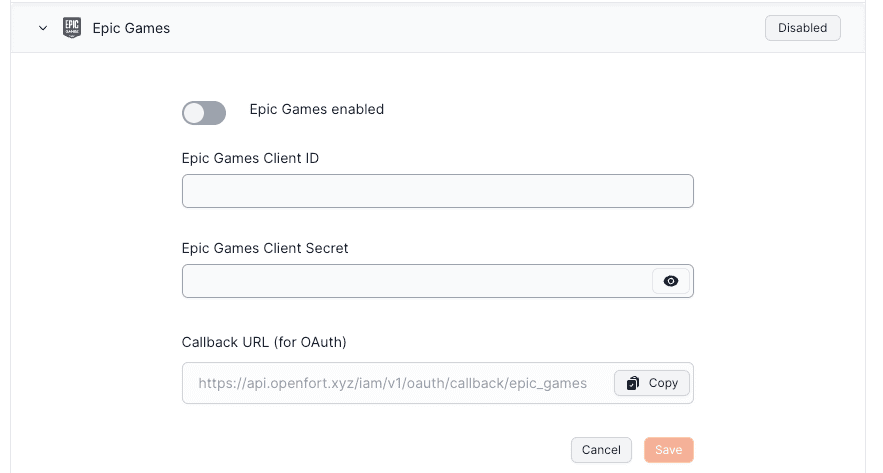Epic Games Login
Learn how to interact with Epic Games Login
To enable Epic Games Auth for your project, you need to set up a Epic Games OAuth application and add the application credentials in the Openfort Dashboard.
Overview#
Setting up Epic Games logins for your application consists of 3 parts:
- Create and configure a Epic Project and App on the Epic Developer Dashboard.
- Add your Epic API Key and API Secret Key to your Openfort Project.
- Add the login code to your Openfort JS Client App.

Configuration#
- Create an organization on Epic Games portal and create a new Product
- Click on Epic Account Services and add a new applications:
- Verify your application website and privacy policy URL
- Save the API Key (client_id) and API Secret Key (client_secret) for later use.
- Set up Epic Games in Openfort:
- Go to the Openfort Project Dashboard.
- Click on the Authentication icon and then Providers.
- Click on Epic Enabled to turn it ON.
- Enter the Epic Client ID and Epic Client Secret.
Signing users in#
To initiate sign in, you can use the initOAuth() method from the Openfort JavaScript library and provide a redirectTo URL which points to a callback route.
- Implicit flow: that's all you need to do. The user will be taken to Google's consent screen, and finally redirected to your app with an access and refresh token pair representing their session.
- Pooling flow: for example in Server-Side Auth, you need to redirect the user back to your website.
Behind the scenes, Openfort Auth uses the Google OAuth 2.0 APIs, which are OpenID Connect certified, to perform the authentication.
To initiate sign in, you can use the initOAuth() method from the Openfort JavaScript library.
- Implicit flow: that's all you need to do. The user will be taken to Google's consent screen, and finally redirected to your app with an access and refresh token pair representing their session.
- Pooling flow: for example in Server-Side Auth, you need to redirect the user back to your website.
_10const response = await openfort.initOAuth(_10 {_10 provider: OAuthProvider.EPIC_GAMES,_10 redirectTo: 'https://your-website.com',_10 }_10);
Now you can redirect the user to the initOAuth.url and when the process is done, you will be redirected to the redirectTo url with tokens https://your-website.com?access_token=...&refresh_token=... You can then use those parameters to authenticate the user:
_10openfort.storeCredentials({_10 player: 'undefined',_10 accessToken: access_token,_10 refreshToken: refresh_token,_10 });
Uppon successful authentication, the SDK will return a token that can be used to authenticate the user in your application.